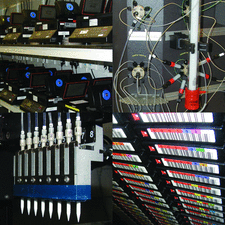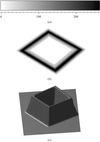issue contents
November 2002 issue
High-throughput structure determination
Proceedings of the CCP4 study weekend

Cover illustration: Tools for enabling high-throughput structural biology at the Henry Wellcome Building for Genomic Medicine and Oxford Protein Production Facility: top-left, PCR machines; top-right, chromatography columns; bottom-left, nanolitre despenser for crystallization trials; bottom-right, data storage/archival robot.
research papers
Open  access
access
 access
accessThe use of the SUPERFAMILY hidden Markov model library in structural genomics is discussed. Target selection is addressed as well as its use for more general inquiry.
Open  access
access
 access
accessProgress in the development of nanocrystallography is discussed and the remaining bottlenecks are highlighted.
Open  access
access
 access
accessA method for the classification of images from crystallization experiments is described.
Open  access
access
 access
accessA system for the automatic classification of images from crystallization trials for use in conjunction with a high-throughput robotic crystallization platform is described.
Open  access
access
 access
accessFully automated data collection and processing would greatly enhance the efficiency of third-generation synchrotron beamlines. A scheme for achieving this goal in a cost-effective and generic way is outlined.
Open  access
access
 access
accessAn overview of the activities of the Collaborative Computational Project Number 4 in protein crystallography is presented.
Open  access
access
 access
accessA procedure for fully automatic structure solution and initial model building is described
Open  access
access
 access
accessACORN facilitates ab initio phasing for protein structures with atomic resolution data. Dynamic density modification and real-space Sayre equation refinement are presented.
Open  access
access
 access
accessPHENIX, a new software system for automated crystallographic structure determination, is described.
Open  access
access
 access
accessA new project to develop an open-source molecular-graphics package is described.
Open  access
access
 access
accessSAD phasing may often be successful in cases intended for MAD, leading to structure solution before the second MAD-wavelength data collection is finished. The background of SAD phasing is presented using various vector diagrams.
Open  access
access
 access
accessFor high-throughput structure determination to have a transforming impact on drug discovery, a whole integrated system of information management, experimental design, quality control, reproducibility checks and in-depth structure analysis needs to be put in place. This is being performed by SGX.


 journal menu
journal menu

























